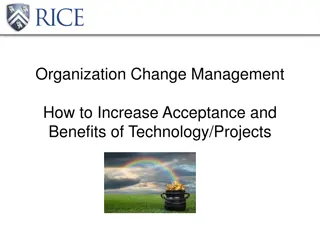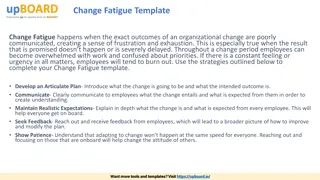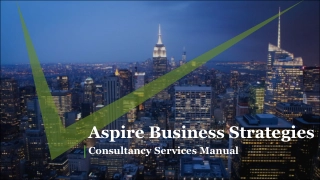Effective Strategies for Managing Change in Business
Explore strategies for managing change in a business setting, including communication, rewards, empowering employees, and transitioning managers from controllers to facilitators. Understand common reasons for employee resistance to change and learn how to effectively navigate these challenges to promote successful organizational change.
Download Presentation

Please find below an Image/Link to download the presentation.
The content on the website is provided AS IS for your information and personal use only. It may not be sold, licensed, or shared on other websites without obtaining consent from the author. Download presentation by click this link. If you encounter any issues during the download, it is possible that the publisher has removed the file from their server.
E N D
Presentation Transcript
Unit 4: Chapter 10 MANAGING CHANGE
Learning Outcomes from this chapter Learning Outcomes from this chapter On completion, you should be able to: Identify the strategies for managing change in a business Explain the changing role of a manager from controller to facilitator Discuss how employee empowerment helps manage relationships Discuss the importance of total quality management Outline the stages in forming new teams Understand the importance of employee participation Understand how technology changes the role of management Explain the impact of technology on personnel/business costs, and business opportunities
Reasons why employee Reasons why employees s may be resistant to change may be resistant to change Loss of job security No obvious reward or benefit Fear of the unknown Fear of failure Inertia, happy with the status quo (individual or cultural)
Strategies for managing change effectively Strategies for managing change effectively 1. Communication 6. Training and development 7. Emphasis on quality TQM and quality assurance 2. Rewards 3. Change from a controller manager to a facilitator manager 8. Lead by example 4. Employee empowerment 9. Teamwork 5. Adequate resource provider 10. Employee participation
1. Communication 1. Communication Open and honest communication is required, where management consult with staff when making changes. This removes the fear of the unknown. When staff are updated regularly, management can explain the motivations for change. 2. Rewards 2. Rewards Management can negotiate with staff and offer increased pay, bonuses, flexi-time, extra holidays or access to training courses to encourage staff to embrace the proposed changes.
3. Change from a controller manager to a 3. Change from a controller manager to a facilitator manager facilitator manager Controllers enforce change and want to keep decision-making power, without including or consulting staff. Facilitators guide and coach staff, empowering them to make changes, showing trust in them to offer solutions. Staff are more energised to work. 4. Employee empowerment 4. Employee empowerment Managers give staff power, freedom and permission to make decisions. When management grant extra responsibility, this shows trust and encourages staff to use their initiative and be motivated. Benefits Quicker decisions, better solutions, increased job satisfaction, better staff Risks Staff unhappy with extra responsibility, staff need training, some poor decisions, loss of control
5. Adequate resource provider 5. Adequate resource provider Provide: new devices (e.g. laptops, software, machines); training (on-the-job and off-the-job courses); time (reduced workload and time allocated to work on change); and more staff (more people hired to spread the extra work). 6. Training and development 6. Training and development Train or re-train staff so they feel better prepared and confident in dealing with change. Enable staff to be more adaptable to change and to work in teams.
7. Emphasis on quality 7. Emphasis on quality TQM and quality assurance assurance TQM and quality Focus on customers Continuous improvement TQM puts the customer at the heart of researching, designing and manufacturing their product TQM businesses strive for zero defects , always trying to highlight areas of production they can improve on Teamwork TQM uses teams to enable decision-making and productivity Employee empowerment TQM gives employees real responsibility, power and trust in decision- making
7. 7. Emphasis Emphasis on quality assurance ( assurance (cont. Quality Assurance: maintaining a desired level of quality; can aim to achieve quality awards on quality TQM and quality TQM and quality cont.) ) Quality awards are internationally recognised and allow a business to charge a higher (premium) price. To achieve an award, systems are improved, which leads to reduced errors. Management and staff work to shorter-term targets, which brings focus. Benefits 8. Lead by example 8. Lead by example When a manager shows they are committed to and believe in change, staff are more likely to accept change too.
9. Teamwork 9. Teamwork Use the matrix structure to increase commitment, purpose, involvement and adaptability. Stages Forming (polite); storming (conflict); norming (routines); performing (excel) Satisfaction, improved human relations, better decision-making, happier staff, lower staff turnover Benefits 10. Employee participation 10. Employee participation Encourage staff to become involved in decisions about the overall running of the business. How? Through work councils, employees as board members, issuing share options Increased involvement, better information available for decisions at top level, control is delegated, staff do not feel uncertain Benefits
Implications of technology for a business Implications of technology for a business Implications Opportunities Costs Finance CAM reduces defects Purchase, installation and maintenance Production More speed, quality, efficiency New machines and training for staff Staff Flexi-time, FaceTime, remote work Redundancies if job replaced by IT Communications Large data analysed quicker (Excel) IT security and encrypted files
Implications of technology for a business Implications of technology for a business ( (cont. cont.) ) Implications Opportunities Costs Marketing Access to new markets through e-commerce Website costs and maintenance Security Digital data more secure, less storage space Costly virus protection Customers Faster for customers to book, complain, etc. IT problems can lead to lost orders

















































